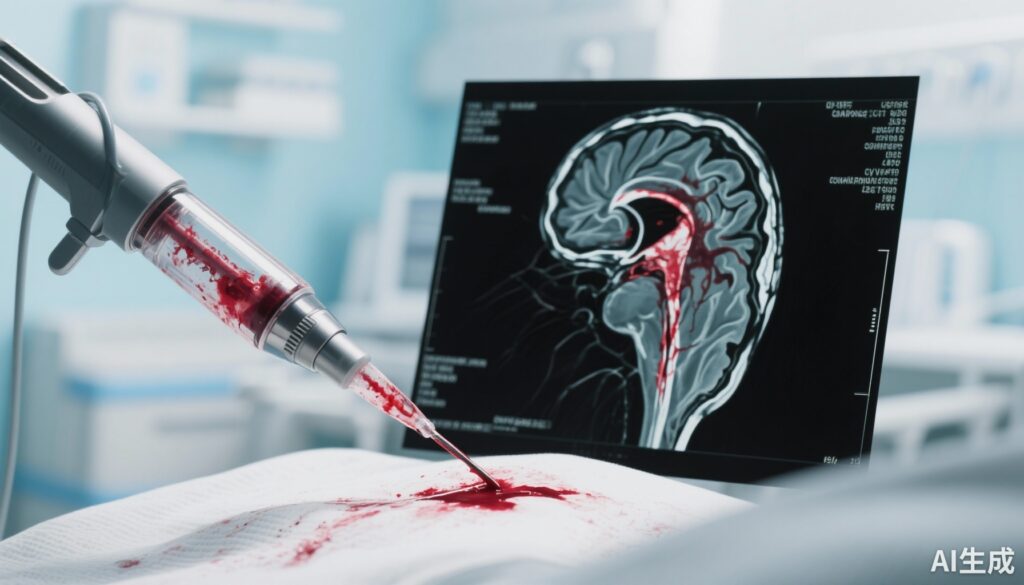Highlight
– The MIND randomized clinical trial evaluated the efficacy and safety of minimally invasive surgery (MIS) with the Artemis Neuro Evacuation Device compared to guideline-based medical management alone in patients with spontaneous supratentorial intracerebral hemorrhage (ICH).
– Despite significant hematoma reduction (median 80.7%) achieved by MIS, no statistically significant improvement was observed in 180-day combined death and disability or 30-day mortality compared with medical management.
– The study was stopped early after enrolling 236 of a planned larger cohort due to feasibility concerns and emerging data from contemporaneous trials.
– Subgroup analyses suggested possible differential effects based on hematoma location (lobar versus deep), but conclusions were limited by sample size.
Study Background and Disease Burden
Intracerebral hemorrhage (ICH) accounts for 10-15% of strokes and is associated with high mortality and morbidity. Supratentorial ICH, involving lobar or deep brain structures, leads to substantial neurological deficit due to hematoma mass effect and secondary injury processes. Currently, there is no consensus on the role of surgical evacuation for spontaneous ICH, as the benefits in terms of functional recovery remain uncertain. Minimally invasive surgery approaches have emerged aiming to reduce surgical trauma and improve outcomes by rapidly evacuating hematomas. However, prior randomized controlled trials have yielded mixed evidence regarding efficacy and safety. The Artemis Neuro Evacuation Device is a novel instrument designed for minimally invasive hematoma removal. The MIND trial aimed to rigorously compare MIS plus standard medical therapy to medical management alone in patients with moderate to large volume supratentorial ICH.
Study Design
MIND was an open-label, international, multicenter randomized clinical trial conducted at 32 global sites between February 2018 and August 2023. Eligible adults aged 18-80 years presenting within 72 hours of spontaneous supratentorial ICH, with hematoma volume 20-80 mL, baseline NIH Stroke Scale score ≥ 6, and Glasgow Coma Scale score 5-15, were randomized in a 2:1 ratio to receive either minimally invasive surgery plus guideline-based medical management or medical management alone. The surgical intervention used the Artemis Neuro Evacuation Device to evacuate the clot. Randomization was stratified by hematoma location and baseline severity. The primary efficacy endpoint was the functional outcome at 180 days, measured by the ordinal modified Rankin Scale (mRS) score, assessing death and disability. The primary safety endpoint was 30-day mortality.
Key Findings
The trial enrolled 236 participants before early termination prompted by an independent feasibility analysis and emerging evidence from related trials. Among these, 154 were randomized to MIS and 82 to medical management. The median age was 60 years; 36.9% were female; 69.5% had deep hemorrhages and 30.5% lobar. The median time from symptom onset to surgery was 27.5 hours, with 38.7% undergoing surgery within 24 hours.
Hematoma Reduction and Procedural Outcomes: MIS achieved a median hematoma volume reduction of 80.7%, lowering median residual volume to 6.3 mL. Nearly 80% had residual hematoma volumes ≤ 15 mL post-procedure. Surgical complication rates were low: external ventricular drain placement occurred in 12.5%, conversion to craniotomy 1.4%, and significant hemorrhage requiring cauterization 6.3% of cases.
Primary Efficacy Outcome: No significant difference was found in the 180-day ordinal mRS between MIS and medical management arms. In the intention-to-treat analysis, the odds ratios were near unity (OR 1.03 unadjusted, OR 1.10 adjusted by strata), and similarly in per-protocol analyses. Secondary endpoints, including dichotomized mRS thresholds (mRS ≤3 or ≤2) and utility-weighted mRS, also showed no significant benefit of surgery. Lengths of stay in ICU and hospital were marginally shorter in the MIS group but without statistical significance.
Primary Safety Outcome and Mortality: Thirty-day mortality was low and comparable between groups (7.2% MIS vs 9.8% medical management; difference -2.5%, 96% CI -11.7% to 4.8%). At 180 days, mortality rates were 13.2% for MIS and 18.3% for medical management. Kaplan-Meier analyses showed no survival difference at 30 days overall, though a separation favoring MIS was observed in lobar but not deep hemorrhages.
Expert Commentary
The MIND trial provides important randomized evidence examining a minimally invasive surgical approach in moderate-to-large supratentorial ICH. Its strengths include rigorous methodology, global multicenter participation, and well-defined clinical endpoints. Despite achieving substantial clot evacuation, MIS using the Artemis device did not translate into improved functional outcomes or survival compared with guideline-based medical management alone within this trial’s sample size and time window.
This aligns with prior literature that questions the net benefit of surgical hematoma evacuation in ICH, emphasizing the complex interplay of brain injury mechanisms, timing, and patient selection. Notably, the majority of hematomas were deep, typically less amenable to surgical intervention, whereas lobar hemorrhages may represent a subgroup with potentially better response to evacuation, as suggested by the Kaplan-Meier analysis. However, these subgroup findings must be considered exploratory given limited sample size and early trial cessation.
Limitations include early stopping reducing power to detect smaller but clinically relevant effects, and the open-label design potentially introducing bias. Additionally, the timing of surgery—with less than 40% treated within 24 hours—may have influenced efficacy, as earlier evacuation might confer more benefit. Future trials with larger cohorts, stratified by hemorrhage characteristics and optimized timing, are warranted.
Conclusion
The MIND randomized clinical trial found that minimally invasive surgery with the Artemis Neuro Evacuation Device within 72 hours of spontaneous supratentorial ICH did not significantly improve 180-day combined death and disability nor reduce 30-day mortality compared to guideline-based medical management alone. While MIS achieved effective clot volume reduction, this did not translate into improved clinical outcomes within this study framework. These findings underscore the ongoing need for tailored therapies in ICH and highlight the importance of further research into patient selection, surgical techniques, and timing to improve prognoses in this challenging condition.
References
Arthur AS, Jahromi BS, Saphier PS, Nickele CM, Ryan RW, Vajkoczy P, Schirmer CM, Kellner CP, Matouk CC, Arias EJ, Ullman JS, Levitt MR, Hage ZA, Fiorella DJ; MIND Study Investigators and Collaborators. Minimally Invasive Surgery vs Medical Management Alone for Intracerebral Hemorrhage: The MIND Randomized Clinical Trial. JAMA Neurol. 2025 Sep 2:e253151. doi: 10.1001/jamaneurol.2025.3151. Epub ahead of print. PMID: 40892424; PMCID: PMC12406146.
Hemphill JC 3rd, Greenberg SM, Anderson CS, et al. Guidelines for the Management of Spontaneous Intracerebral Hemorrhage: A Guideline for Healthcare Professionals From the American Heart Association/American Stroke Association. Stroke. 2015 Jul;46(7):2032-60. doi: 10.1161/STR.0000000000000069.
Zhang F, Li Q, Jiang J, et al. Surgical vs conservative treatment of spontaneous supratentorial intracerebral hemorrhage: A systematic review and meta-analysis of randomized controlled trials and observational studies. CNS Neurosci Ther. 2020 Sep;26(9):826-833. doi: 10.1111/cns.13388.




I’m truly enjoying the design and layout of your site. It’s a very easy on the eyes which makes it much more enjoyable for me to come here and visit more often. Did you hire out a developer to create your theme? Great work!